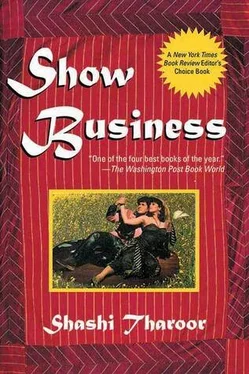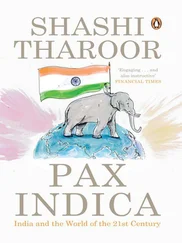“And what about the heroine, do I hear you ask?” There is unctuous laughter, I am not sure why. “I shall tell you. Do you know why Brahma, the divine Creator in the Hindu trinity, is always depicted with four heads? There is a story that goes back to the time when he created woman — yes, the female human. He carved her out of his own body, not from a spare rib; you see, we are a vegetarian people.” (More appreciative laughter. The devotees obviously found this rib-tickling.) “Now in those days Brahma had only one head, that’s all he had need of at the time. But he admired his own creation, this First Woman, so much, and looked at her so ardently, that she felt obliged to hide in embarrassment from his desire. This she tried to do by running away from his line of vision, but if Brahma could create a woman, he could certainly create an extra pair of eyes. So in order to be able to see her wherever she hid, he grew a head on each side, another one behind, and even one on top, to complement his original single head. Is this not like the ubiquitous camera of the Hindi film?
“But to return to Brahma. Inevitably the woman could not escape him, and she succumbed to his desire. Out of this consummation came the birth of our original ancestors, the founders of the human race. Wait a minute, I hear the accountants among you saying, That story gives Brahma five heads — why is he portrayed only with four? Well, there is a postscript to the story. The other members of the divine trinity did not entirely approve of Brahma being able to look up into the heavens as well as keeping an eye on earth. So Siva, a god of action if ever there was one, took his sword and cut off the top head, leaving Brahma with four. Like the Hindi filmmaker, Brahma can look around and beneath him, but not rest his gaze on higher things.”
The devotees nod, while I wonder what on earth any of this has to do with his main point. Or indeed whether he has a main point at all.
“But I digress. We have talked about the creation of woman, but not about her role as heroine. Here I must turn a little to Vedanta; I hope my foreign brothers and sisters will be patient with me. The universe is made from, and made up of, two simultaneous Causes, or principles — a spiritual Cause called purusha, the male principle, and a nonspiritual Cause called prakriti, nature, seen as female. I am sorry, dear ladies, that you are not seen as spiritual: perhaps too many of our ancient philosophers were men. But the mutual interdependence of these two principles is fundamental — the male principle cannot create anything without the female nor can prakriti produce the natural universe without purusha. Now what is this prakriti, this female principle? It is made up of three gunas, three basic qualities: the shining; the dark, or passive; and the dynamic. This is the tradition from which the Hindi film heroine is unconsciously drawn. She shines, she is resplendent, she is fair (and this is important, because it is said that the goddess Parvati, criticized by her husband, Siva, for her dark complexion, had to perform austerities and penances in the forest before Brahma granted her the fair skin for which she is now famed. No Indian actress can succeed without reminding audiences of the postpenance Parvati.) She is also passive, the object of the hero’s adoration and the villain’s lust. But these two gunas remain in uneasy equilibrium; it is the third, her dynamism, that unsettles this equilibrium and makes the Indian film heroine a heroine.”
This is going right over my head, a direction in which no real Hindi film heroine has yet traveled. I shift my weight uncomfortably from one thigh to the other and try to admire the curve of the Frenchwoman’s unhaltered breast, which pushes against her saffron shift like prakriti looking for a purusha.
“You would be right, my dears, in tracing the modern Hindi film to the epics and myths of our ancient times,” the Guru goes on. “Each character fulfills the role assigned to him or her in the film as each of us fulfills the role assigned to us by our destiny on this earth, our dharma. The Hindi film hero’s dharma is to be a hero, the villain’s is to be a villain. It is the same, after all, in the Mahabharata, whose personages act out their roles without being able to deviate in the slightest from the script of destiny. Their dharma determines their character, and their character determines their destiny; yet even this dharma is the result of their actions in their past lives. There is nothing they can do about it: they do what they do because they are who they are, and they are who they are because they have done what they did. This is a concept you can apply in toto to the Hindi film hero.
“A prime example of this species is now sitting among us. He has come to seek the benefits of my wisdom, and this pleases me. So for his sake, I shall conclude this discourse with a story from the Mahabharata — not, alas, a story like the delectable episode of Brahma and his lady — but the story of an argument, a debate, shall we say, among the five Pandava brothers, the ’heroes,’ if you must, of the great epic. The topic they were debating was a typically Hindu question of hierarchies. Which, they argued, was the highest of human pursuits — kama, pleasure; artha, wealth; or dharma, righteousness? Their uncle and counselor, Vidura, thought the matter was self-evident: the answer was obviously dharma. Arjuna, the most intelligent of the Pandavas, was not so sure: he put artha first, regarding pleasure and righteousness as merely two adjuncts of wealth. (He would obviously have made a very successful merchant-banker today.) Bhima, the glutton and strong man, disagreed. In his view, the satisfaction of desire, in other words kama, was obviously man’s first duty, since without the desire to achieve, any achievement would be impossible. The twin brothers, Nakula and Sahadeva, wanted it both ways: man, they declared, should go for all three — first pursue righteousness, then wealth, and lastly, pleasure. (I am beginning to think they had a point there, but not necessarily in that order.) Finally, the oldest brother, Yudhisthira, paragon of virtue, surveyed the options and sadly rejected all of them. The only thing for a man to do, he concluded, was to sidestep the debate altogether and submit himself to Fate.
“I will not draw the lessons from this argument for you. It is yours to interpret as you see fit. But today we have with us a man who has sampled kama, accumulated artha, and seeks to fulfill a dharma of service to the people. He has my benediction.”
And with that the Guru closes his eyes and resumes his posture of meditation. The devotees rise silently and begin to shuffle out soundlessly on bare feet.
I stand up, delighted by the unexpectedly positive conclusion to the Guru’s rambling discourse, but uncertain what happens next. Ashwin, satisfied, is already heading for the door. I stop the Frenchwoman as she walks toward it.
“Don’t I get to see him now?” I ask. “Privately?”
“Can’t you see? Ze Guru his meditating,” she replies.
“But I’ve come all this way just to talk to him,” I say.
“What you ’ave to say, ze Guru already knows,” she declares sententiously. “Ze Guru alone decides hif’e needs to talk to you.”
Ashwin beckons. He doesn’t want me to make a fuss.
“Wait.” The Frenchwoman looks at her master. The Guru has opened one eye owlishly and is raising a hand. Slowly, he points at me and beckons. When Ashwin and the devotee try to follow me, he stops them with upraised palm. A long finger opens out and points exclusively to me. It folds back, a peremptory summons. I ought to feel insulted, but I find myself enjoying the privilege. “Private audience,” I say, shrugging at the Frenchwoman. She folds her hands to the Guru and walks out with Ashwin, shutting the door. I am alone with the man of God.
Читать дальше












